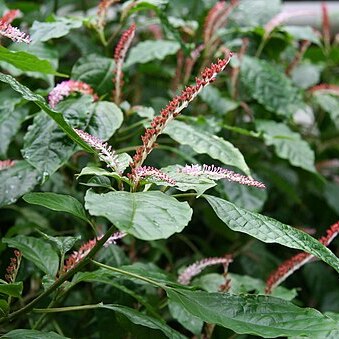Leaves: lamina 4.5–15 × 2.0–6.5 cm., ovate-elliptic to elliptic, pubescent to glabrescent along veins below and sometimes along midrib above; petioles 5–55 mm. long, pubescent on superior surface.
A shrubby annual herb. It grows 2 m tall. The stems are erect. They are slender and branched. The leaves are alternate and simple. The leaf blade is 8-16 cm long by 4-8 cm wide.
Racemes to 15 cm. long in fruit; rhachis pubescent to glabrescent; pedicels c. 2 mm. long in flower, to 4 mm. in fruit, glabrous.
Sepals 1.5–2 × 1–1.25 mm. in flower, broadly elliptic to obovate, apex rounded, glabrous, green or white.
Fruit 2.0–2.5 mm. in diam., ridged around margin; pericarp very thin, adhering to seed.
Bracts c. 1.5 mm. long, caducous, glabrous to setulose (particularly along margins).
Herbs or sub-shrubs up to c. 1.5 m. tall, stems pubescent on younger parts.
Ovary 1–1.5 mm. tall; style very short; stigma capitate.
Fruits yellow or orange, then deep purplish-black.
Stamens 4, approximately same length as sepals.
Corolla white in a yellow or pinkish raceme
Seed same shape as fruit; testa hard.
Perennial herb, often woody below
Bracteoles minute.

